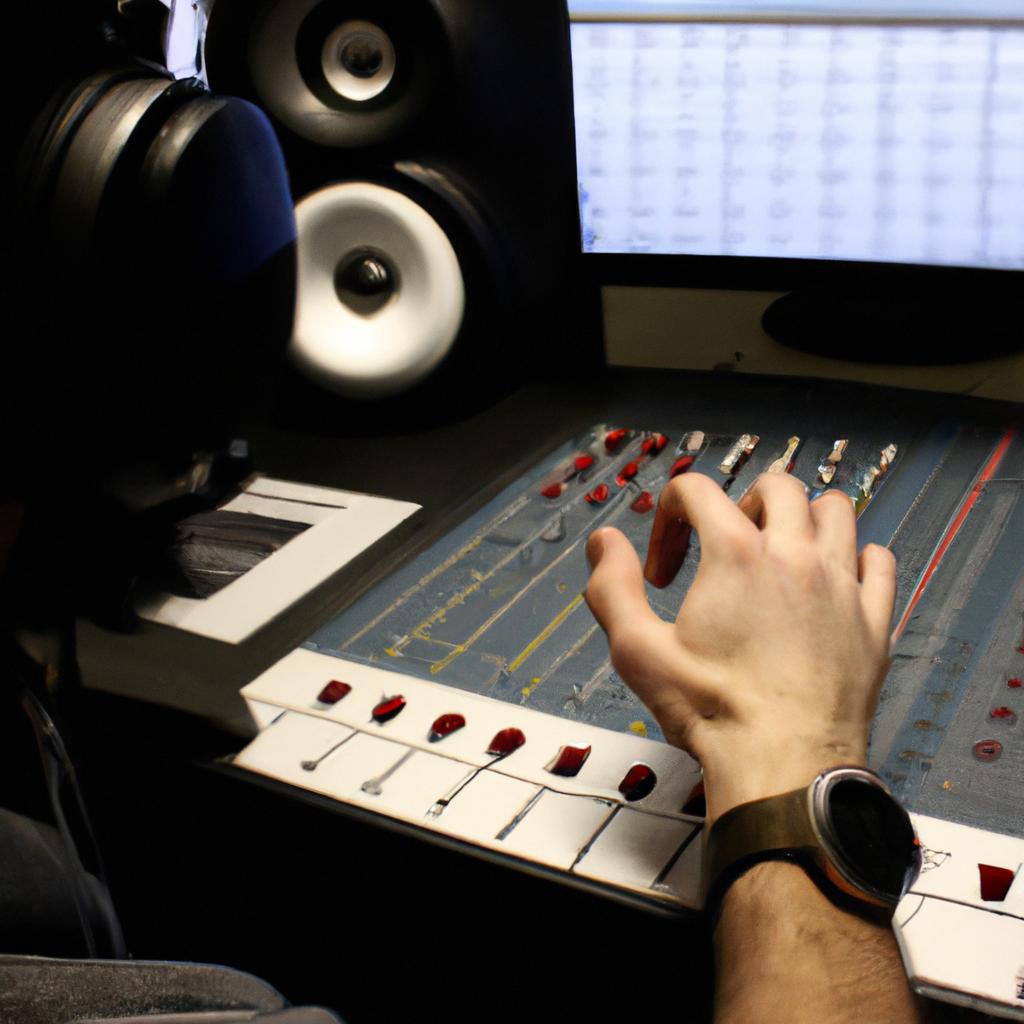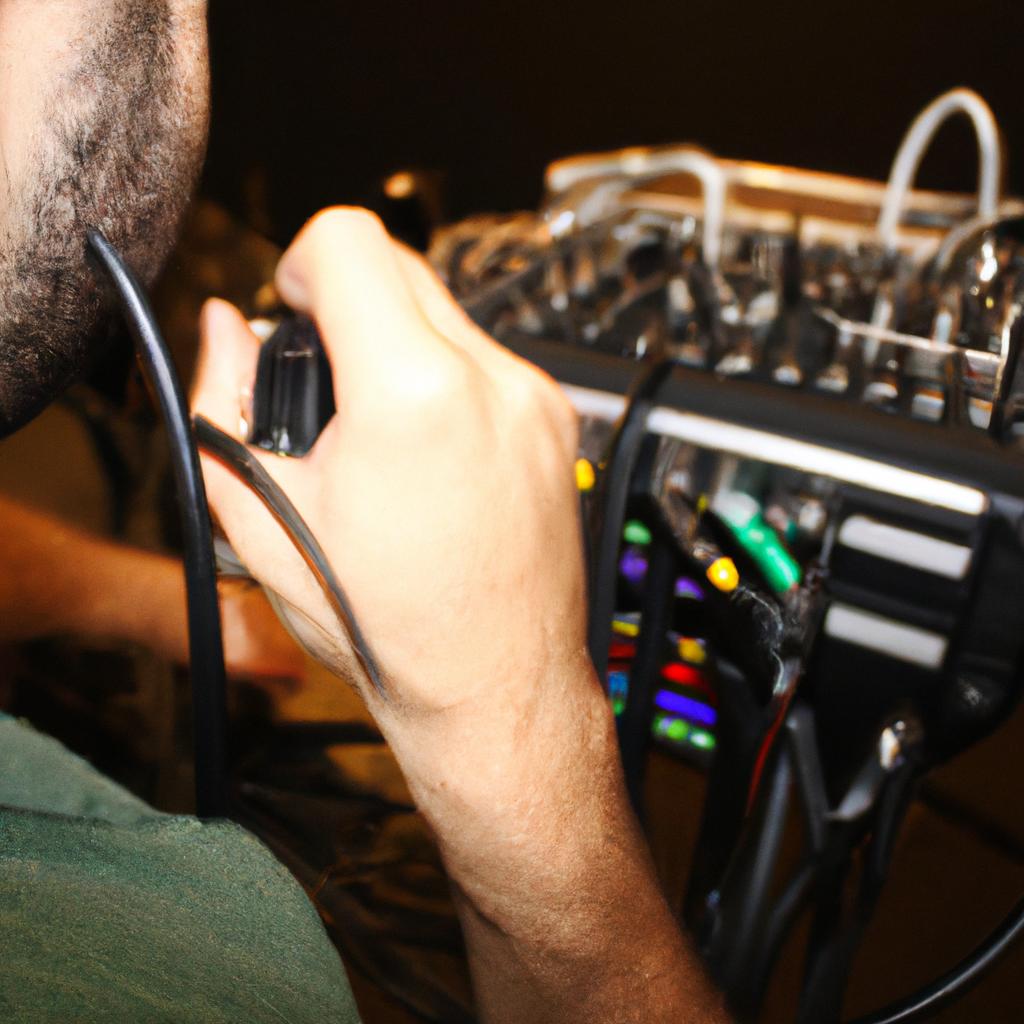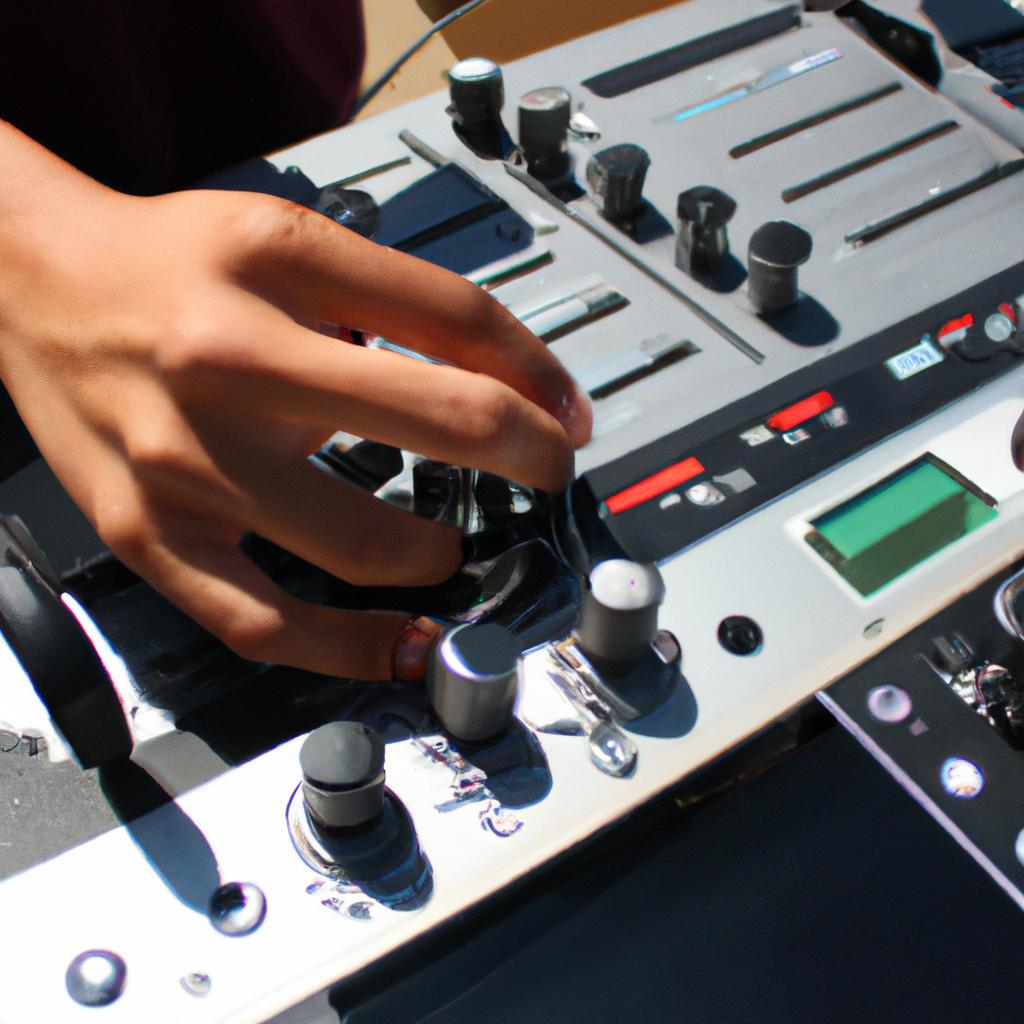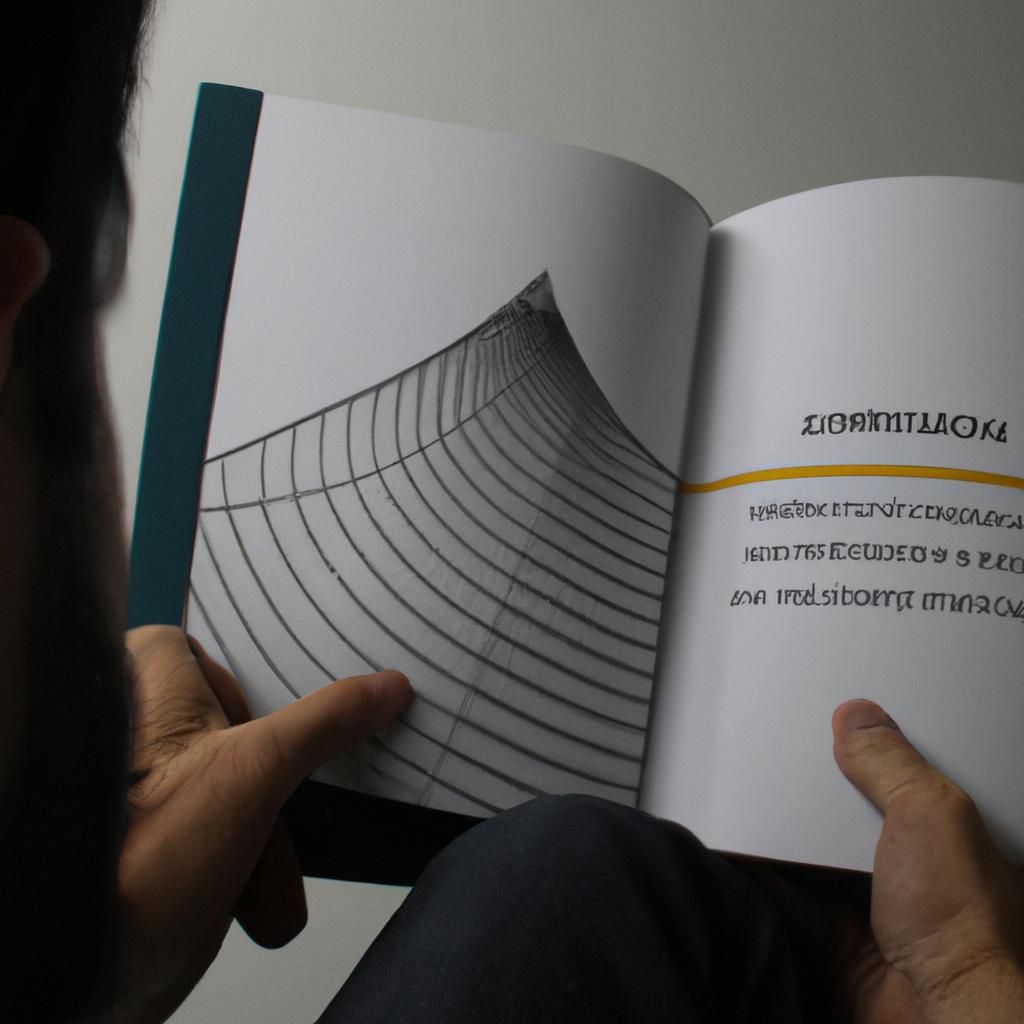In the realm of audio recording, achieving a high-quality sound and capturing the intended vision is paramount. This article delves into the intricate processes of mixing and mastering, exploring how they contribute to shaping the sonic landscape in audio recordings. By examining these two essential steps in detail, we can gain a deeper understanding of their significance in enhancing the overall listening experience.
To illustrate this importance, let us consider a hypothetical scenario: an aspiring musician meticulously records an original composition using professional equipment. Despite putting immense effort into capturing each instrument’s nuances, there is still something lacking when playing back the recorded tracks. The guitar sounds dull, the drums lack punch, and the vocals are buried amidst a sea of competing frequencies. In this case, without proper mixing and mastering techniques, even exceptional musicianship may be overshadowed by subpar production values.
The art of mixing involves balancing individual elements within a song to create a cohesive auditory experience. It entails adjusting levels, panning instruments across the stereo field, applying equalization (EQ), dynamics processing, and effects such as reverb or delay. Through careful manipulation of these parameters, mix engineers strive to achieve clarity and depth while highlighting key musical elements—resulting in an immersive sonic environment that captivates listeners from start to finish.
Mastering, on the other hand, takes the final mix and prepares it for distribution across various platforms and formats. Mastering engineers focus on refining the overall sound of a recording, ensuring consistency and cohesiveness across multiple tracks or an entire album. They address any sonic imbalances, fine-tune frequencies, apply compression or limiting to control dynamics, adjust stereo width, and optimize the audio for playback on different devices. Additionally, mastering involves sequencing songs in a specific order to create a cohesive listening experience from track to track.
Both mixing and mastering are crucial stages in the production process that require technical expertise and artistic sensibility. Skilled professionals utilize their ears, knowledge of audio equipment, and software tools to bring out the best qualities in each recording. They act as objective listeners who can identify areas that need improvement while preserving the artist’s intent.
It is worth noting that while mixing and mastering techniques can greatly enhance audio recordings, they cannot compensate for poorly recorded source material. Therefore, it is essential to capture high-quality recordings initially by using proper microphone placement, suitable room acoustics, quality instruments/equipment, and skilled musicianship.
In conclusion, mixing and mastering play pivotal roles in shaping the sonic landscape of audio recordings. Through careful manipulation of various elements such as levels, EQ, dynamics processing, and effects during mixing—and refining the overall sound through optimization during mastering—these processes contribute significantly to creating an immersive listening experience that showcases the intended vision of the artist or producer.
The Basics of Mixing and Mastering
Imagine you are a music producer tasked with mixing and mastering an album for a rising artist. In order to achieve the best possible sound quality, it is essential to understand the basics of these two crucial stages in audio recording. This section will provide an overview of mixing and mastering, highlighting their significance and outlining key techniques used by professionals.
Mixing involves blending individual tracks together to create a cohesive and balanced sound. It allows you to adjust various elements such as volume levels, panning positions, and effects settings. By carefully manipulating these parameters, you can enhance the overall sonic experience and ensure that each instrument or voice occupies its own space within the mix. For instance, imagine a rock song where the guitar solo needs to stand out without overpowering the vocals; proper mixing ensures that both elements coexist harmoniously.
To evoke an emotional response in listeners through effective mixing and mastering, consider the following:
- Clarity: Clear sounds enable listeners to fully appreciate every detail in a recording.
- Depth: Creating depth adds dimensionality and immerses listeners into the musical landscape.
- Balance: A well-balanced mix ensures no single element dominates over others.
- Dynamic Range: Properly managing dynamic range enhances emotional impact by accentuating quiet moments before explosive crescendos.
In addition to understanding these concepts, mastering plays a vital role in delivering a polished final product. Think of it as fine-tuning—a process applied after mixing—to optimize the entire album’s sound on multiple platforms and playback systems. Mastering further refines tonal balance, stereo imaging, loudness consistency between tracks, and prepares them for distribution.
| Technique | Purpose |
|---|---|
| Equalization (EQ) | Enhances frequency balance by adjusting specific bands |
| Compression | Controls dynamics by reducing peak volumes while boosting softer sections |
| Stereo Imaging | Manipulates width and depth perception of the audio |
| Limiting | Increases overall loudness by preventing peaks from exceeding a specified threshold |
Understanding the role of EQ in audio production, which will be explored in detail in the subsequent section, is vital to shaping individual elements within a mix and achieving desired tonal characteristics. By employing various techniques like EQ, compression, stereo imaging, and limiting during both mixing and mastering stages, you can transform raw recordings into professional-sounding tracks that captivate audiences.
With this foundation established, let us now delve deeper into understanding the role of EQ in audio production.
Understanding the Role of EQ in Audio Production
Building upon the foundational knowledge of mixing and mastering, we now delve into the crucial role that EQ plays in audio production. Understanding how to effectively use EQ is essential for achieving a balanced and polished sound. Let us explore this topic further.
Example: Imagine you are working on a recording of a live band performance. The vocals may be drowned out by the instruments or certain frequencies might overpower others, resulting in an imbalanced mix. By using EQ techniques, you can enhance the clarity of the vocals while also ensuring each instrument occupies its proper sonic space.
Using EQ involves manipulating different frequency bands within the audio spectrum to either boost or attenuate specific elements of a sound. Here are some key considerations when applying EQ:
- Frequency Range: Identify which frequencies need adjustment based on their impact on the overall balance and desired tonal characteristics.
- Q Factor: Determine the width of the affected frequency range—narrower bandwidths allow precise control over specific frequencies, while wider bandwidths affect broader sections of the spectrum.
- Cut vs Boost: Decide whether to reduce (cut) or increase (boost) levels within particular frequency ranges to achieve desired tonal shaping.
- Musicality: Take into account how adjustments interact with other elements in the mix as well as musical context, aiming for a harmonious blend rather than isolated changes.
To illustrate these concepts more visually, consider the following table showcasing common frequency ranges and their corresponding characteristics:
| Frequency Range | Characteristics |
|---|---|
| Sub-Bass | Deep rumble |
| Bass | Low-end presence |
| Midrange | Vocals, melodic instruments |
| Presence | Clarity and definition |
| Brilliance | Sparkle and airiness |
By understanding these frequency ranges and their associated qualities, it becomes easier to identify where adjustments are needed to improve audio quality.
Utilizing compression techniques for a polished sound, we now move into the next stage of audio production. This process involves further refining and sculpting the sonic elements to achieve professional-level recordings.
Utilizing Compression Techniques for a Polished Sound
Building upon our understanding of the role of EQ in audio production, we now delve into another crucial aspect of the mixing and mastering process—utilizing compression techniques for a polished sound.
One example that demonstrates the effectiveness of compression is when working with vocals. Imagine a scenario where you have recorded an expressive vocal performance, but certain sections are much louder than others. By applying compression to the vocal track, you can control these inconsistencies, resulting in a more balanced and professional sound. Compression works by reducing the dynamic range—the difference between the loudest and softest parts—of an audio signal.
To effectively utilize compression in your mix, consider the following key points:
- Threshold: Set the threshold level at which compression begins to take effect. Adjusting this parameter determines how sensitive or aggressive the compressor reacts to incoming signals.
- Ratio: Determine the ratio of attenuation applied to signals above the threshold level. Higher ratios result in more pronounced compression effects.
- Attack and Release: Control how quickly or slowly the compressor responds to changes in volume levels. The attack time dictates how soon compression engages after exceeding the threshold, while release time determines how long it takes for compression to disengage once below the threshold.
- Makeup Gain: After applying compression, use makeup gain to bring up any lost volume caused by attenuation during compression.
| Key Point | Description |
|---|---|
| Threshold | Sets starting point |
| Ratio | Determines amount of control |
| Attack & Release | Controls response times |
| Makeup Gain | Restores volume post-compression |
By incorporating effective compression techniques into your workflow, you can achieve greater clarity, balance, and cohesion within your mix. This essential tool allows you to tame unruly dynamics and enhance overall sonic quality. As we move forward, we will explore how to create spatial depth with reverb and delay, further enriching the sonic experience for listeners.
With a solid foundation in compression techniques established, let us now turn our attention towards creating spatial depth with reverb and delay.
Creating Spatial Depth with Reverb and Delay
Building upon the polished sound achieved through compression techniques, we now turn our attention to another crucial aspect of audio recording – creating spatial depth with reverb and delay. By harnessing these effects, engineers can transform a flat mix into one that is immersive and captivating for listeners.
To illustrate the power of reverb and delay in shaping the sonic landscape, consider an example scenario where a band is recording a live performance in a large concert hall. As they play their music, the sound waves produced bounce off the walls, ceiling, and other surfaces before reaching the audience’s ears. This natural reverberation adds richness and depth to the overall listening experience.
When replicating this effect during post-production, engineers employ reverb plugins or hardware units to recreate the acoustic properties of different spaces. By adjusting parameters such as decay time, predelay, and diffusion, they can simulate anything from small rooms to grand cathedrals. The choice of reverb type depends on various factors like genre, instrumentation, and desired mood.
In addition to reverb, engineers also utilize delay effects to enhance spatial perception within a mix. Delays are created by repeating a sound source at varying intervals over time. Short delays add thickness and dimension to individual tracks while longer delays create echoes that contribute to the perceived distance between instruments. By skillfully combining both reverb and delay effects throughout a mix, engineers can transport listeners into unique sonic environments that complement the artistic vision of each song.
- Evoking feelings of nostalgia
- Enhancing emotional impact
- Expanding sonic horizons
- Enveloping listeners in an ethereal atmosphere
| Reverb | Delay | |
|---|---|---|
| 1 | Creates sense of space | Adds thickness and dimension |
| 2 | Simulates acoustic properties of different environments | Enhances perceived distance between instruments |
| 3 | Adjust parameters for desired mood and genre | Adds rhythmic interest to tracks |
| 4 | Contributes to overall immersion and listener engagement | Creates unique sonic landscapes that enhance the artistic vision of each song |
As we explore the intricacies of sound engineering, it becomes evident that achieving balance and panning in a mix is as critical as utilizing compression techniques or creating spatial depth. By skillfully manipulating these elements, engineers can ensure that every instrument finds its rightful place within the stereo field while maintaining clarity and cohesiveness throughout the entire production process.
The Importance of Balance and Panning in the Mix
In the previous section, we explored how reverb and delay can be used to create spatial depth in audio recordings. Now, let’s delve into another crucial aspect of mixing and mastering: the importance of balance and panning in achieving a well-rounded mix.
Imagine you’re listening to a song where all the instruments are competing for attention at the same volume level, resulting in a muddy and cluttered sound. By properly balancing the elements within a mix, you can ensure that each instrument has its own space and clarity. For example, imagine a rock band consisting of drums, bass guitar, electric guitar, and vocals. To achieve balance, you might lower the volume of the bass guitar slightly to allow the kick drum to punch through more prominently. Additionally, you could pan the guitars on either side of the stereo field to create width while leaving room for the lead vocal to sit front and center.
To further understand why balance is essential in mixing, consider these key points:
- Balance allows for proper separation between instruments.
- Achieving balance enhances clarity and definition in individual sounds.
- Balancing instruments ensures that no element dominates or gets lost in the mix.
- Properly balanced mixes provide an immersive experience for listeners.
Consider this table showcasing how different levels of balance impact audio quality:
| Level of Balance | Impact on Audio Quality |
|---|---|
| Imbalanced | Muddy and cluttered |
| Slightly Balanced | Some clarity |
| Well-Balanced | Clear and defined |
By understanding how panning affects spatial placement and using appropriate volume adjustments to achieve balance, you can elevate your mix from amateurish to professional-sounding. In our next section about “Achieving Professional Quality with Mastering Techniques,” we’ll explore additional techniques that will help refine your audio recording even further.
Achieving Professional Quality with Mastering Techniques
Building upon the concept of balance and panning in the mix, we now delve into the crucial role of mastering techniques in achieving professional quality audio recordings.
To understand the significance of mastering, let us consider a hypothetical scenario. Imagine a talented musician who has just recorded an album at a reputable studio. The tracks sound great individually, but when played back together as a cohesive unit, something feels amiss. This is where mastering comes into play – it ensures that all the songs on an album have consistent tonal balance, volume levels, and overall sonic quality.
Mastering involves several essential steps to enhance and polish the final mix before its distribution or release. Here are some key elements involved in this process:
- Equalization (EQ): By carefully adjusting frequency bands, EQ helps correct any imbalances in tone and enhances clarity across different instruments and vocals within each track.
- Compression: Used judiciously, compression reduces dynamic range variations between loud and soft sounds, resulting in a more controlled and balanced listening experience.
- Stereo enhancement: Utilizing stereo widening techniques can create a sense of spaciousness by broadening the stereo image without compromising mono compatibility.
- Loudness optimization: In today’s competitive music landscape, ensuring that your tracks stand out requires proper loudness optimization while maintaining dynamics for an enjoyable listening experience.
- Enhances sonic quality through careful adjustments
- Creates consistency among tracks on an album
- Adds depth and dimension to recordings
- Ensures optimum loudness levels for modern platforms
| Mastering Techniques | Purpose |
|---|---|
| Equalization | Corrects tonal imbalances |
| Compression | Controls dynamic range |
| Stereo Enhancement | Expands spatial perception |
| Loudness Optimization | Optimizes volume for broader appeal |
In conclusion,
Mastering serves as the final touch in audio production, elevating a recording to its full potential. By applying techniques such as equalization, compression, stereo enhancement, and loudness optimization, mastering engineers can ensure that an album maintains consistent tonal balance throughout while enhancing overall sonic quality. Its significance lies not only in improving individual tracks but also in creating cohesion and professionalism across an entire record.












